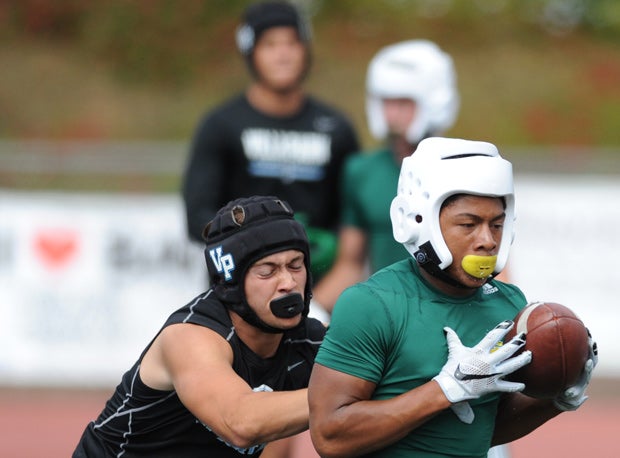Video: USA Football/MaxPreps High School Football Media Day hosted by the San Francisco 49ers
MaxPreps teamed with USA Football and the 49ers last season to share ways to keep players safeSome say football is a contact sport, but they're missing the point: Football is a collision sport – and along with those high-velocity collisions comes a risk of concussion.
And just as the National Football League and NCAA have made adjustments to try and minimize the frequency of concussions and head injuries, so too has the National Federation of State High School Associations, and this fall, the implementation of reforms first proposed in October 2014 are spreading across the nation.
The most controversial NFHS recommendation is to limit full-contact practices to two or three days a week during the season. In addition, the NFHS committee recommended that full contact be limited to no more than 30 minutes a day, and between 60 and 90 minutes per week.
Bob Colgate, the director of sports and sports medicine for the NFHS, acknowledged that "a balance" must be maintained, as young players must learn how to handle contact without having too much of it.
"We don't want to jeopardize players by not having enough full-contact practice," he said.
To that end, the committee's guidelines for preseason practice suggest that full contact makes sense every day, but that during two-a-days full contact should only take place in one session.
Colgate also was quick to point out that NFHS is a federation, and thus can't mandate what states can or cannot do, and it's up to individual state associations to create and enforce these recommendations – which is one reason that it's taken more than a year for many of these guidelines to be adopted. Each state association received the NFHS report in October 2014, but many, if not most, states created committees of their own to study the suggestions and determine the best course of action for their particular states.
Only after the committees had made their reports could state associations change their rules, and implementing them for the 2015 season was often impractical.
But now, rules are changing across the country and many states have adopted some or all of the following recommendations:
1) During preseason, only one full-contact session per day.
2) During the regular season, two or three full-contact sessions per week.
3) No more than 30 minutes per day of full contact, and a maximum of between 60 and 90 minutes per week.
4) Thud drills should be considered full-contact.
5) An emphasis on proper technique and principles in preseason.
6) Eliminating multiple competitions – a player participating in both a frosh and JV game, for example – during the same week.
7) Monitoring off-season, full-contact sessions.
8) Educating coaches about concussion symptoms and dangers.
9) Having an emergency action plan in place for head injuries.

Safety is the name of the game in just about all football activities, and coaches must adapt to stay within the rules.
Photo by Ming Chung Lin
MaxPreps' resident coaching expert Chris Fore is an assistant in California and said that the California Interscholastic Federation has implemented some of those recommendations. Kids in California can hit no more than 45 minutes per practice and only twice per week. There is also an 18-hour rule that limits the amount of time coaches can spend in team activities, and games count as three hours.
Naturally, these guidelines have met with some opposition, primarily from old-school coaches and fans, but given the increasing evidence of the long-term potential damage from head injuries, the tide of reform is running high.
"With what we know now about the brain, and numerous hits and impacts on the brain, it's pretty wild to think about how football used to be practiced. I remember my first year as a head coach, it was 2003. We practiced for 5-6 hours per day on the field during training camp two-a-days," said Fore. "That was certainly a whole lot of exposure to kids. I think that what the new regulations have done to coaches is that they have made us critically think about the hows and whys of what we do. We have to work smarter, not harder, than the next guy to get our work done."
Players, parents and coaches should also be aware that risk varies, depending on a variety of factors:
1) Position – linemen receive more total blows than other players.
2) Time on the field – two-way players will naturally be involved in more collisions.
3) Technique – blocking and tackling with proper technique is crucial in avoiding head injuries.
4) Practice frequency and duration.
5) Multi-team players – those who practice with varsity and junior varsity, for example.
6) Concussion history – the best predictor of future concussions is past concussions.
7) Genetics – some people are more prone to concussions than others.
Football remains by far the most popular sport in high school, for fans and male athletes, with more than 1 million participants. But the risk for injury is high.
Head injuries are especially dangerous, as players often don't show symptoms right away, so the NFHS recommendations may only be the first step in trying to keep them to a minimum. At the higher levels, for example, there is talk of removing kickoffs from the game entirely, and even though high school athletes can't generate the force and power of bigger, stronger, older players, the increased emphasis on player safety is bound to become a permanent part of the football landscape.
